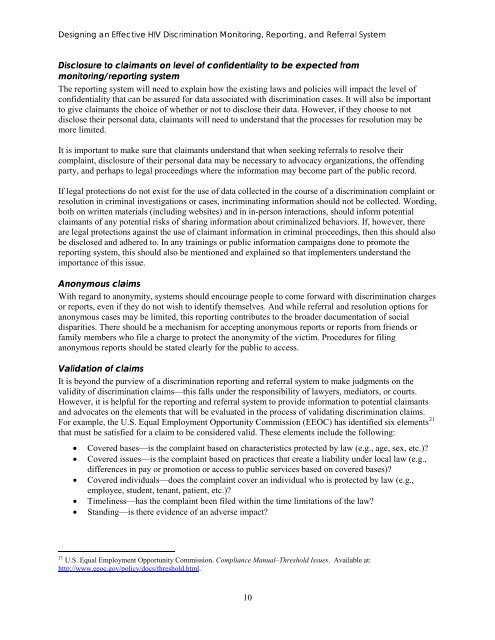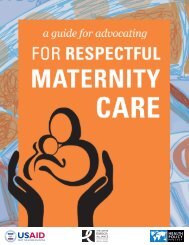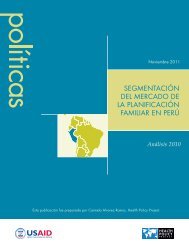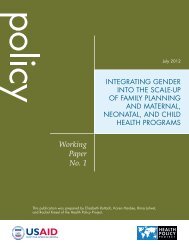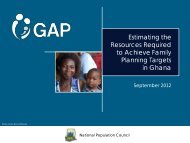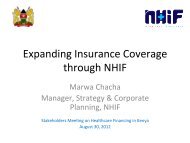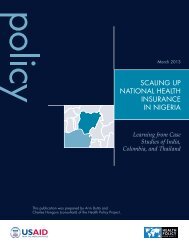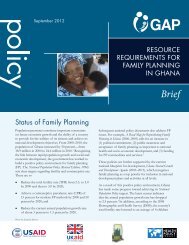English Version - Health Policy Project
English Version - Health Policy Project
English Version - Health Policy Project
Create successful ePaper yourself
Turn your PDF publications into a flip-book with our unique Google optimized e-Paper software.
Designing an Effective HIV Discrimination Monitoring, Reporting, and Referral System<br />
Disclosure to claimants on level of confidentiality to be expected from<br />
monitoring/reporting system<br />
The reporting system will need to explain how the existing laws and policies will impact the level of<br />
confidentiality that can be assured for data associated with discrimination cases. It will also be important<br />
to give claimants the choice of whether or not to disclose their data. However, if they choose to not<br />
disclose their personal data, claimants will need to understand that the processes for resolution may be<br />
more limited.<br />
It is important to make sure that claimants understand that when seeking referrals to resolve their<br />
complaint, disclosure of their personal data may be necessary to advocacy organizations, the offending<br />
party, and perhaps to legal proceedings where the information may become part of the public record.<br />
If legal protections do not exist for the use of data collected in the course of a discrimination complaint or<br />
resolution in criminal investigations or cases, incriminating information should not be collected. Wording,<br />
both on written materials (including websites) and in in-person interactions, should inform potential<br />
claimants of any potential risks of sharing information about criminalized behaviors. If, however, there<br />
are legal protections against the use of claimant information in criminal proceedings, then this should also<br />
be disclosed and adhered to. In any trainings or public information campaigns done to promote the<br />
reporting system, this should also be mentioned and explained so that implementers understand the<br />
importance of this issue.<br />
Anonymous claims<br />
With regard to anonymity, systems should encourage people to come forward with discrimination charges<br />
or reports, even if they do not wish to identify themselves. And while referral and resolution options for<br />
anonymous cases may be limited, this reporting contributes to the broader documentation of social<br />
disparities. There should be a mechanism for accepting anonymous reports or reports from friends or<br />
family members who file a charge to protect the anonymity of the victim. Procedures for filing<br />
anonymous reports should be stated clearly for the public to access.<br />
Validation of claims<br />
It is beyond the purview of a discrimination reporting and referral system to make judgments on the<br />
validity of discrimination claims—this falls under the responsibility of lawyers, mediators, or courts.<br />
However, it is helpful for the reporting and referral system to provide information to potential claimants<br />
and advocates on the elements that will be evaluated in the process of validating discrimination claims.<br />
For example, the U.S. Equal Employment Opportunity Commission (EEOC) has identified six elements 21<br />
that must be satisfied for a claim to be considered valid. These elements include the following:<br />
• Covered bases—is the complaint based on characteristics protected by law (e.g., age, sex, etc.)<br />
• Covered issues—is the complaint based on practices that create a liability under local law (e.g.,<br />
differences in pay or promotion or access to public services based on covered bases)<br />
• Covered individuals—does the complaint cover an individual who is protected by law (e.g.,<br />
employee, student, tenant, patient, etc.)<br />
• Timeliness—has the complaint been filed within the time limitations of the law<br />
• Standing—is there evidence of an adverse impact<br />
21 U.S. Equal Employment Opportunity Commission. Compliance Manual–Threshold Issues. Available at:<br />
http://www.eeoc.gov/policy/docs/threshold.html.<br />
10


